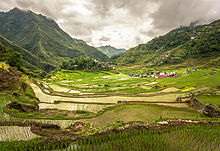
Back Arrozales en terraces de los cordales de Filipines AST Terrasses d'arròs de les serralades filipines Catalan Rýžové terasy filipínských Kordiller Czech Reisterrassen in den philippinischen Kordilleren German Αναβαθμίδες Ορυζώνων των Κορδιλιέρων των Φιλιππίνων Greek Arrozales en terrazas de las cordilleras de Filipinas Spanish تراسهای برنجی کوردیلرای فیلیپین Persian Rizières en terrasses des cordillères des Philippines French טרסות האורז של הקורדילרה הפיליפינית HE Terase rižinih polja filipinskih Kordiljera Croatian
| UNESCO World Heritage Site | |
|---|---|
 Batad Rice Terraces, Ifugao Province, Philippines | |
| Location | Ifugao, Cordillera Administrative Region, Luzon, Philippines |
| Includes |
|
| Criteria | Cultural: (iii)(iv)(v) |
| Reference | 722 |
| Inscription | 1995 (19th Session) |
| Endangered | 2001–2012[1] |
| Coordinates | 16°56′2″N 121°8′12″E / 16.93389°N 121.13667°E |








The Rice Terraces of the Philippine Cordilleras are a World Heritage Site consisting of a complex of rice terraces on the island of Luzon in the Philippines. They were inscribed on the UNESCO World Heritage List in 1995, the first-ever property to be included in the cultural landscape category of the World Heritage List.[2] This inscription has five sites: the Batad Rice Terraces and Bangaan Rice Terraces (both in Banaue), Mayoyao Rice Terraces (in Mayoyao), Hungduan Rice Terraces (in Hungduan) and Nagacadan Rice Terraces (in Kiangan), all in Ifugao Province. The Ifugao Rice Terraces reach a higher altitude and were built on steeper slopes than many other terraces. The Ifugao complex of stone or mud walls and the careful carving of the natural contours of hills and mountains combine to make terraced pond fields, coupled with the development of intricate irrigation systems, harvesting water from the forests of the mountain tops, and an elaborate farming system.
The Ifugao Rice Terraces illustrate the remarkable ability of human culture to adapt to new social and climate pressures as well as to implement and develop new ideas and technologies. Although listed by the UNESCO as a World Heritage site believed to be older than 2,000 years, recent studies from the Ifugao Archaeological Project report that they were actually constructed upon Spanish contact about 400 years ago.[3][4][5][6][7]
Maintenance of the living rice terraces reflects a primarily cooperative approach of the whole community which is based on detailed knowledge of the rich diversity of biological resources existing in the Ifugao agro-ecosystem, a finely tuned annual system respecting lunar cycles, zoning and planning, extensive soil conservation, and mastery of a complex pest control regime based on the processing of a variety of herbs, accompanied by religious rituals.
- ^ Cite error: The named reference
delistingwas invoked but never defined (see the help page). - ^ Malig, Jojo (June 26, 2012). "Philippine Rice Terraces No Longer in Danger". ABS-CBN News. Retrieved June 26, 2012.
- ^ Cabreza, Vincent (July 15, 2013). "For Ifugao Rice Terraces, Age Should Not Matter". Inquirer.net. Retrieved January 29, 2018.
- ^ Ranada, Pia (April 29, 2015). "Ifugao Rice Terraces May Be Younger than We Think". Rappler. Retrieved January 29, 2018.
- ^ Acabado, Stephen B.; Koller, Jared M.; Liu, Chin-hsin; Lauer, Adam J.; Farahani, Alan; Barretto-Tesoro, Grace; Reyes, Marian C; Martin, Jonathan Albert; Peterson, John A. (2019). "The Short History of the Ifugao Rice Terraces: A Local Response to the Spanish Conquest". Journal of Field Archaeology. 44 (3): 195–214. doi:10.1080/00934690.2019.1574159. S2CID 133693424.
- ^ Acabado, Stephen (2018). "Zones of Refuge: Resisting Conquest in the Northern Philippine Highlands Through Environmental Practice". Journal of Anthropological Archaeology. 52: 180–195. doi:10.1016/j.jaa.2018.05.005. S2CID 150245254.
- ^ Acabado, Stephen B. (2015). Antiquity, Archaeological Processes, and Highland Adaptation: The Ifugao Rice Terraces. Quezon City: Ateneo de Manila University Press.
© MMXXIII Rich X Search. We shall prevail. All rights reserved. Rich X Search

